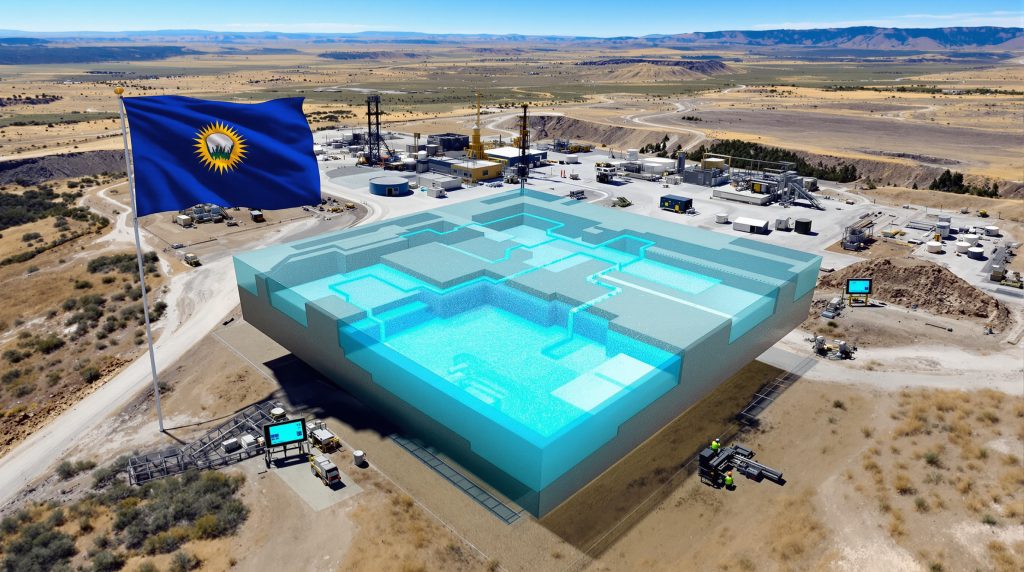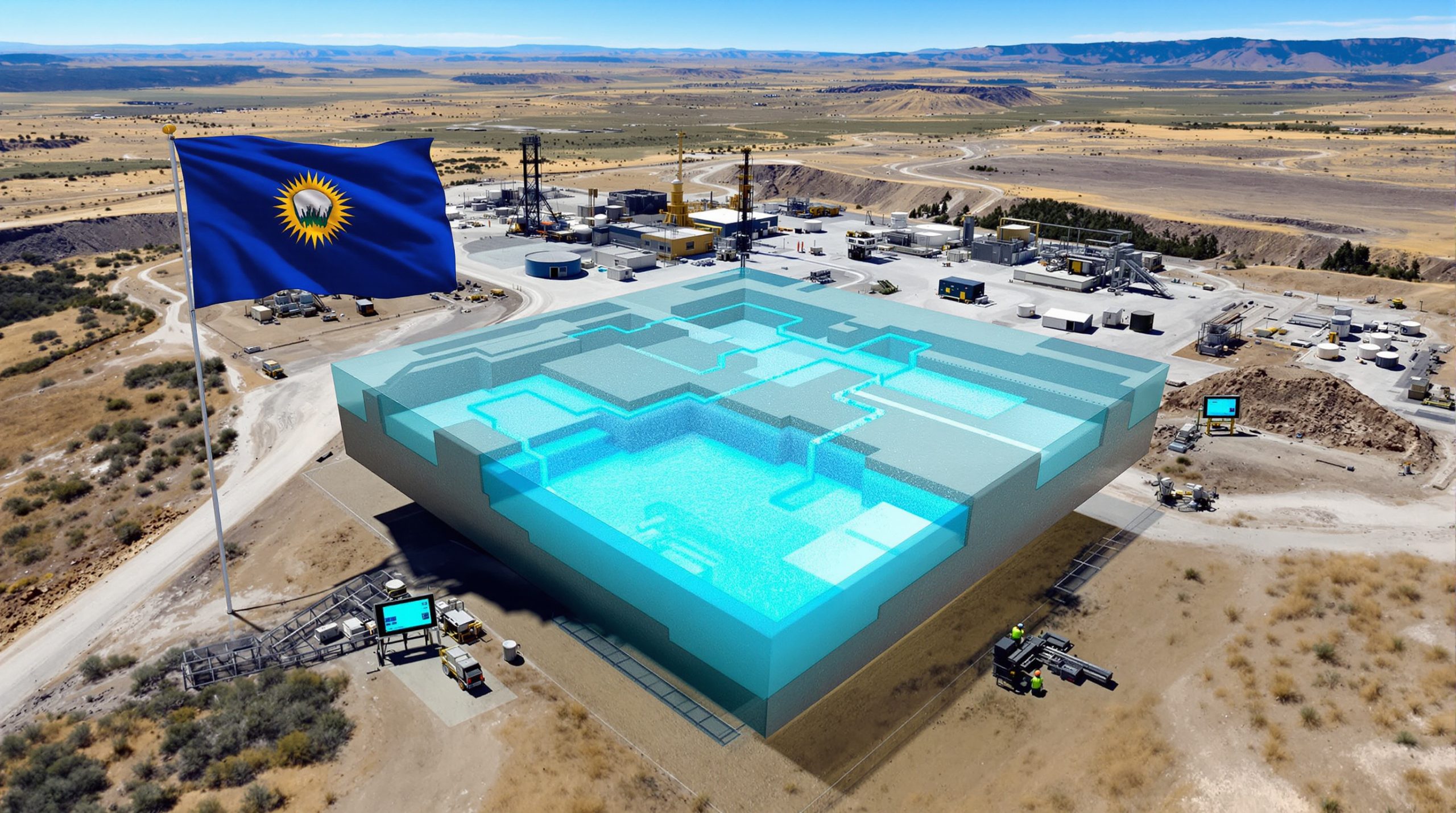Understanding the Importance of Groundwater Monitoring in Mining Operations
Groundwater monitoring stands as a cornerstone of environmental stewardship in modern mining operations, particularly for projects involving critical minerals like rare earth elements. At Wyoming's Cowboy State Mine, part of the Halleck Creek Deposit, comprehensive Cowboy State Mine groundwater monitoring represents more than regulatory compliance—it establishes the foundation for responsible resource development while protecting vital water resources.
The recent completion of a 24-hour groundwater monitoring well pump test at Cowboy State Mine demonstrates the meticulous approach required for environmental baseline data collection. This testing process delivers critical hydrological information necessary for regulatory submissions while simultaneously providing essential inputs for ongoing Pre-Feasibility Study engineering work.
Professional hydrologists from WWC Engineering in Sheridan, Wyoming oversaw the testing process, ensuring data integrity and scientific rigor. The resulting dataset supports the development of sophisticated three-dimensional groundwater models that regulatory authorities require as part of the permit to mine application process.
For mining companies, establishing robust baseline environmental conditions before operations begin serves multiple purposes. It creates a scientific reference point against which future water quality and quantity measurements can be compared, enables early detection of potential impacts, and demonstrates environmental commitment to both regulators and stakeholders.
What Makes Groundwater Monitoring Essential for Mine Development?
Beyond regulatory requirements, groundwater monitoring delivers significant operational value throughout a mine's lifecycle. By characterizing underground water resources before mining begins, companies gain critical insights that influence everything from pit design to processing requirements.
Three-dimensional groundwater models developed from monitoring data help predict how mining activities might affect local hydrology. These digital simulations enable engineers to visualize subsurface water movement, identify potential pathways for contaminant transport, and develop appropriate mitigation strategies where necessary.
For rare earth element mining operations like Cowboy State Mine, water considerations take on additional importance due to the processing requirements associated with these critical minerals. Understanding water availability, flow rates, and quality characteristics supports both environmental protection and modern mine planning.
The integration of environmental and technical planning represents a best practice approach in modern mining. Rather than treating environmental monitoring as a separate regulatory exercise, forward-thinking companies incorporate hydrological data directly into mine design and operational planning, ensuring technical decisions are grounded in solid environmental understanding.
How Do Pump Tests Contribute to Environmental Baseline Data?
Pump tests represent specialized methodologies within groundwater monitoring programs that yield particularly valuable datasets. The 24-hour test conducted at Cowboy State Mine under Wyoming Department of Environmental Quality permit demonstrates this approach.
During pump tests, water is extracted from monitoring wells at controlled rates while technicians measure changes in water levels across the monitoring network. This controlled extraction reveals crucial information about aquifer characteristics, including:
- Flow rates and sustainable yields
- Volumetric capacity of underground reservoirs
- Degree of hydrological connectivity between different areas
- Potential impacts of dewatering activities during mining operations
The results help determine how groundwater behaves across the deposit area, providing greater insight into subsurface conditions. For the Cowboy State Mine, this information feeds directly into environmental baseline documentation while simultaneously informing technical planning for the Pre-Feasibility Study.
The hydrological data from pump tests carries significant value beyond regulatory submissions. It helps engineers understand how mining activities might affect groundwater conditions, enabling proactive planning to minimize potential impacts while maximizing operational efficiency.
What Technical Parameters Are Measured During Groundwater Monitoring?
Comprehensive groundwater monitoring programs collect diverse datasets that build a complete picture of subsurface hydrological conditions. For operations like Cowboy State Mine, key parameters typically include:
| Parameter Category | Specific Measurements | Significance for Mining Operations |
|---|---|---|
| Physical Properties | Flow rates, hydraulic gradients, water levels | Determines dewatering requirements and potential drawdown effects |
| Chemical Composition | pH, dissolved minerals, metals content | Establishes baseline water quality for future comparison |
| Hydrological Connectivity | Response times between wells, drawdown patterns | Reveals potential pathways for groundwater movement |
| Volumetric Data | Sustainable yield, recharge rates | Informs water management planning for processing operations |
These measurements support the development of sophisticated groundwater models that simulate potential impacts under various mining scenarios. For rare earth element projects like Cowboy State Mine, understanding these parameters enables proactive water management throughout the operation's lifecycle.
The volumetric and flow-rate data obtained through monitoring directly informs both mine design and mineral processing considerations. This integration ensures technical planning remains grounded in reliable environmental data, reducing operational risks while supporting environmental protection.
Why Is Regulatory Compliance Critical for Mining Projects?
Regulatory compliance represents more than a procedural hurdle for mining operations—it provides a structured framework for environmental protection while creating predictability for project development. In Wyoming, the Department of Environmental Quality–Land Quality Division (WDEQ–LQD) oversees mining permits with particular attention to water resources.
For Cowboy State Mine, the groundwater monitoring program satisfies several regulatory objectives:
- Establishes pre-mining baseline conditions as reference points
- Demonstrates understanding of local hydrological systems
- Provides data necessary for environmental impact assessment
- Supports the development of appropriate monitoring plans during operations
The three-dimensional groundwater model required as part of the permit to mine application serves as a cornerstone in meeting regulatory expectations around environmental safeguards. This model helps regulators evaluate potential impacts while providing the company with valuable planning tools.
Regulatory compliance also creates a standardized approach to environmental protection that benefits both mining companies and communities. By establishing clear requirements and processes, regulatory frameworks help ensure all operations meet minimum environmental standards while creating a level playing field for resource development.
How Does Wyoming's Regulatory Framework Apply to Mining Operations?
Wyoming has developed a comprehensive yet streamlined regulatory approach that balances resource development with environmental protection. The Wyoming Department of Environmental Quality–Land Quality Division (WDEQ–LQD) serves as the primary regulatory authority for mining operations, with specific requirements for environmental baseline data collection.
The state's permit system covers groundwater monitoring activities through a structured process that includes:
- Permit applications for monitoring well installation and testing
- Requirements for professionally supervised data collection
- Standards for data analysis and modeling
- Integration of environmental data into mine planning
For projects like Cowboy State Mine, Wyoming's regulatory framework provides clarity around environmental requirements while supporting responsible development. This balanced approach has positioned Wyoming as an attractive jurisdiction for mining projects, particularly those involving critical minerals like rare earth elements.
The state's emphasis on comprehensive baseline data collection ensures mining companies thoroughly understand environmental conditions before operations begin. This approach benefits both regulators and operators by establishing clear reference points for environmental protection throughout the mine lifecycle.
What Role Do Professional Hydrologists Play in Mining Projects?
Professional hydrologists provide specialized expertise essential for both regulatory compliance and operational planning in mining projects. At Cowboy State Mine, hydrologists from WWC Engineering in Sheridan, Wyoming oversee groundwater monitoring activities, bringing scientific rigor and technical knowledge to the process.
These specialists contribute to mining projects in several key ways:
- Designing appropriate monitoring well networks to capture representative data
- Conducting pump tests according to scientific protocols
- Analyzing complex hydrological datasets to extract meaningful insights
- Building and calibrating three-dimensional groundwater models
- Preparing technical documentation for regulatory submissions
Their involvement provides support to both the regulatory and engineering aspects of the project, ensuring environmental data meets scientific standards while delivering practical value for operational planning. This interdisciplinary collaboration represents a best practice approach in modern mining development.
Professional hydrologists also help interpret complex groundwater behavior patterns that might not be immediately apparent from raw data. Their expertise in subsurface water dynamics enables mining companies to anticipate potential challenges and develop appropriate management strategies before operations begin.
How Does Groundwater Data Influence Mine Design and Operations?
Groundwater monitoring data directly influences multiple aspects of mine planning and operations, creating a foundation for technically sound and environmentally responsible development. At Cowboy State Mine, the hydrological information from monitoring activities informs several critical aspects of project planning:
Pit Design Considerations
Understanding groundwater levels, flow patterns, and pressure gradients helps engineers determine optimal pit configurations, slope angles, and potential dewatering requirements. This information directly impacts both safety parameters and operational efficiency.
Processing Water Requirements
Volumetric data from groundwater assessments informs planning for mineral processing operations, which often require significant water resources. Understanding sustainable yields helps ensure adequate water availability throughout the operation's lifecycle.
Infrastructure Placement
Hydrological information guides decisions about where to locate processing facilities, waste storage areas, and other infrastructure to minimize environmental impacts while maximizing operational efficiency.
Operational Water Management
Groundwater models help develop comprehensive water management plans that address both operational needs and environmental protection. These plans include strategies for water conservation, treatment, and potential reuse.
Closure Planning
Baseline hydrological data establishes reference points for eventual mine closure and reclamation planning, ensuring post-mining land use objectives can be achieved through appropriate restoration measures.
This integration of environmental data into technical planning reflects a holistic approach to project development. Rather than treating environmental considerations as separate constraints, mining operations like Cowboy State Mine incorporate hydrological understanding directly into project design.
What Technologies Are Advancing Groundwater Monitoring Capabilities?
Recent technological advancements have significantly enhanced groundwater monitoring capabilities for mining projects. Modern operations benefit from increasingly sophisticated tools that improve data collection accuracy, analysis capabilities, and integration with other environmental monitoring systems.
Key technological innovations include:
- Real-time monitoring systems that provide continuous data collection rather than periodic sampling, enabling immediate detection of potential changes
- Advanced modeling software capable of simulating complex hydrogeological conditions with greater accuracy and three-dimensional visualization
- Remote sensing technologies that complement direct measurements with broader landscape-level data
- Automated sampling equipment that increases data collection efficiency and reliability while reducing human error
- Data integration platforms that combine multiple environmental parameters for comprehensive analysis
These technologies support more thorough environmental assessment while potentially reducing monitoring costs through automation and improved efficiency. For projects like Cowboy State Mine, leveraging these technological capabilities enhances both regulatory compliance and operational planning.
The evolution toward digital environmental monitoring aligns with broader industry trends toward data-driven mining operations. By capturing more comprehensive datasets with greater accuracy, mining companies can develop increasingly precise environmental management strategies that protect resources while supporting operational objectives.
How Does Groundwater Monitoring Support Sustainable Mining Practices?
Comprehensive groundwater monitoring programs contribute fundamentally to sustainable mining practices through several mechanisms:
- Establishing clear environmental baselines before mining begins
- Enabling early detection of potential impacts during operations
- Supporting adaptive management approaches based on monitoring results
- Providing data for continuous improvement in water management
- Building stakeholder trust through transparent environmental monitoring
This approach aligns with growing expectations for responsible resource development, particularly for critical minerals like rare earth elements that face increasing demand for clean energy technologies and other advanced applications. Proactive environmental management becomes especially important for these strategic resources.
By integrating environmental monitoring directly into operational planning, mining companies demonstrate commitment to responsible development while potentially reducing operational risks. This integrated approach represents an evolution in industry thinking from regulatory compliance toward environmental stewardship as a core business principle.
For rare earth element projects like Cowboy State Mine, sustainable practices take on additional significance given these materials' importance in renewable energy technologies. The environmental footprint of producing these critical minerals deserves particular attention to ensure their application in clean technologies doesn't come at an unacceptable environmental cost.
What Are the Long-term Benefits of Comprehensive Groundwater Programs?
Mining companies that implement robust groundwater monitoring programs realize several long-term benefits that extend beyond regulatory compliance:
-
Regulatory Efficiency: Well-documented baseline data can streamline future permitting processes and regulatory interactions, potentially reducing project delays.
-
Operational Risk Reduction: Understanding hydrogeological conditions helps mitigate water-related operational risks, from potential pit flooding to water supply constraints.
-
Stakeholder Relations: Transparent environmental monitoring builds trust with local communities and other stakeholders, supporting the social license to operate.
-
Environmental Protection: Early detection of potential issues allows for proactive management before significant impacts occur, preserving ecological values.
-
Corporate Responsibility: Comprehensive environmental programs demonstrate commitment to responsible resource development, enhancing corporate reputation.
These benefits extend beyond individual projects to support broader industry sustainability and social license to operate. For critical minerals development like rare earth elements at Cowboy State Mine, demonstrating environmental responsibility becomes particularly important given these materials' strategic significance.
The long-term value of thorough environmental baseline data grows throughout a project's lifecycle. Initial investments in comprehensive monitoring pay dividends during operations through risk reduction, during potential expansions through streamlined permitting, and during closure through clear remediation targets.
FAQ: Groundwater Monitoring for Mining Operations
What is the primary purpose of groundwater monitoring at mining sites?
Groundwater monitoring establishes baseline environmental conditions, tracks potential impacts during operations, ensures regulatory compliance, and provides essential data for mine planning and water management strategies.
How long does typical groundwater monitoring continue at mining operations?
Comprehensive monitoring typically begins during exploration phases, continues throughout active mining operations, and extends into post-closure monitoring, often spanning decades to ensure long-term environmental protection.
What technologies are used in modern groundwater monitoring programs?
Modern programs utilize monitoring wells, automated sampling equipment, real-time data collection systems, advanced modeling software, and integrated environmental monitoring platforms to provide comprehensive hydrological assessment.
How do regulatory requirements for groundwater monitoring vary by location?
Regulatory frameworks vary significantly between jurisdictions, with some regions requiring extensive pre-mining baseline data collection spanning multiple seasons, while others may have more streamlined requirements focused on specific parameters of concern.
What role does groundwater monitoring play in mine closure planning?
Groundwater monitoring provides essential data for developing effective closure plans, establishing remediation targets if needed, and demonstrating successful mine reclamation innovation to regulatory authorities and stakeholders.
How can mining companies optimize groundwater monitoring programs?
Optimization involves strategic monitoring well placement, appropriate sampling frequencies, integration with other environmental monitoring, and adaptive management approaches that adjust monitoring based on operational phases and observed conditions.
Further Exploration
Readers interested in learning more about groundwater monitoring for mining operations can explore educational resources from industry associations, regulatory agencies, and academic institutions specializing in mining and environmental management. These resources provide additional perspectives on evolving best practices, technological innovations, and regulatory trends affecting environmental monitoring in the mining sector.
For the Cowboy State Mine specifically, the groundwater monitoring program represents a critical milestone in the project's development pathway. As rare earth elements continue growing in strategic importance for clean energy technologies and other advanced applications, environmentally responsible development of these resources becomes increasingly significant both locally and globally.
The ongoing mining sustainability transformation across the industry emphasizes the importance of effective mining waste management and environmental monitoring systems. These practices ensure critical mineral resources can be developed with minimal environmental impact while maximizing their contribution to clean energy transitions and technological advancement.
Want to Get Instant Alerts on the Next Major Mineral Discovery?
Enhance your investment strategy with Discovery Alert's proprietary Discovery IQ model, which delivers real-time notifications on significant ASX mineral discoveries before the wider market reacts. Explore why major mineral discoveries can lead to substantial returns by visiting the Discovery Alert discoveries page and position yourself for potential investment opportunities.




